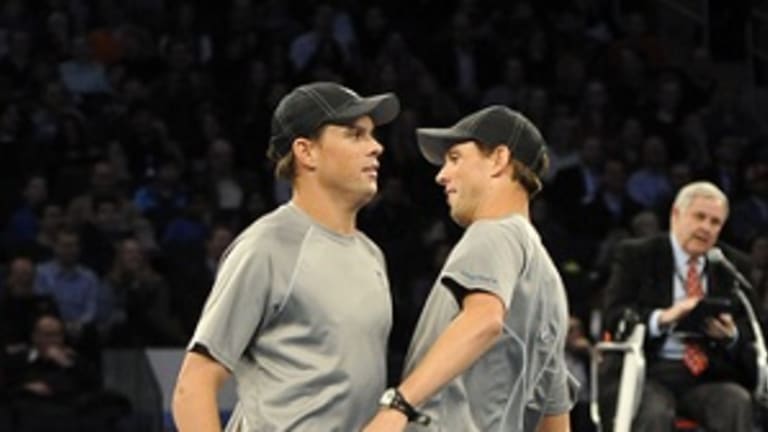NEW YORK—By the time Mike Bryan intercepted Patrick McEnroe’s service return to send a vicious, cut-volley back the other way, but on the other side of the net and parallel with it, John McEnroe knew he was in deep trouble. He scowled and twisted his head in in disbelief, either at the quality of Bryan’s shot or — more fitting, if not more likely — at the jam he’d gotten himself into.
A few months ago, McEnroe had bought himself a fair share of grief for slagging off the Bryans and criticizing the current state of doubles. Among other things, he said, “I don’t know what doubles is bringing to the table. The doubles are the slow guys who aren’t quick enough to play singles. Would it be better off, no disrespect, but would it be better off if there was no doubles at all. . .?"
This was considered heresy, given that McEnroe himself — often described as the greatest doubles player of all time — had always been such a passionate advocate for doubles. Where could it have come from, some wondered?
The answer seemed fairly obvious: The Bryan brothers had eclipsed the most significant doubles records and established themselves as the greatest doubles team ever. The demotion did not sit well with McEnroe, who’s never been averse to fresh interpretations of reality.
That kerfuffle was bad enough, given how much the Bryans had done for the doubles game. It also flew in the face of evidence and history. As much as McEnroe may resent the rise of the “double specialist,” the breed is neither new nor deleterious to doubles.
Fact: Unlike McEnroe, the top singles players in his era were just as indifferent to the challenge of doubles as today’s singles stars (just look up the doubles record of Jimmy Connors, Ivan lendl, or Bjorn Borg). Fact also: Doubles specialists have always existed, and they make the tandem game more rather than less competitive.
You could easily write off that original dust-up to John McEnroe being John McEnroe (and in general, God bless him for it). But for some reason McEnroe continued chewing that bite. In a convoluted monologue delivered in the pre-event press conference for Monday’s BNP Paribas Showdown, Mac defended his position and heaped even more fuel on the fire.
First off, he wondered if anyone, including himself, knew what he had said and suggested the blame lay for the controversy lay with the British newspapers (in truth, McEnroe’s controversial comments appeared in the highly credible Times of London). No sooner did he say that than he segued into his underlying real beef, which is that he’s tired of all this talk about how current players are so much stronger and fitter than the men of his vintage.
Somehow he related all that that to his original comments about doubles in a way that seemed, at best, condescending — prompting Bob Bryan to ask: “So you’re saying we’re ‘crap’ and we should just eat it?”
“That’s a twisted way of reading that,” McEnroe replied. “But if you want to read it that way. . . I’m sure it will be in the English papers tomorrow that way.”
Well, you can imagine how the Bryans and their hands-on dad Wayne felt about that exchange. And that made the doubles on Monday night an intriguing proposition, even if it was just an exhibition — even if it matched a dominant, present-day team against a pair of aging brothers, even if it was just an eight-game pro set.
John McEnroe, as we all know, is still playing some great tennis at age 55. He won 78 doubles titles, including nine majors. He’s playing so well that my colleague Tom Perrotta is convinced that, should McEnroe team up with a player like Rafael Nadal at Indian Wells next week they might well win the title.
McEnroe’s brother Patrick is 47. He won 16 doubles titles in his career, including one major. As Davis Cup captain for many years, Pat coached the Bryans through numerous weeks, and has the utmost respect for them — and their game (Mike would later quip that Patrick was a “prisoner of war” in the match).These days, though, Patrick is saddled with so many responsibilities that he gets few chances to get a serious workout. So this exo doubles was clearly a mis-match, despite the novelty value in a “battle of the brothers.” The actual points and games quickly underscored just how lopsided the pairing was.
The Bryans simply killed it. They had power the Macs couldn’t match or handle, and signature Bryan brothers teamwork confirming that sometimes the thought and act really are indistinguishable from each other. At one point, the Bryans at the net volleyed about a dozen balls right back at the McEnroes, who proved unable to go either through or over them.
Long story short: in the blink of an eye it was 7-0, one game from a humiliating shutout. The promoters had planned to give the fans — and concessionaires — a little break between the doubles and the singles, but this was ridiculous. The Bryans mysteriously lost the next two games, but then closed it out, 8-3.
As always, revenge proved to be a dish best served cold.
What was interesting to me, though, was how the Bryans really seemed to be playing a different game — even when I factored in all the elements in the mis-match. It echoed something Bob had said earlier in the day: “Doubles has changed a lot. He (John McEnroe) probably doesn’t recognize the way it’s played today. It’s completely different from the serve and volley tennis and the amazing hands that he had.”
McEnroe pooh-poohed that comment at the time and predicted that “we’ll see” how different it is when the McEnroe’s serve — and stay back.
We say how it was when the McEnroes served and stayed back.
It was ugly.
And not for Bob and Mike.
